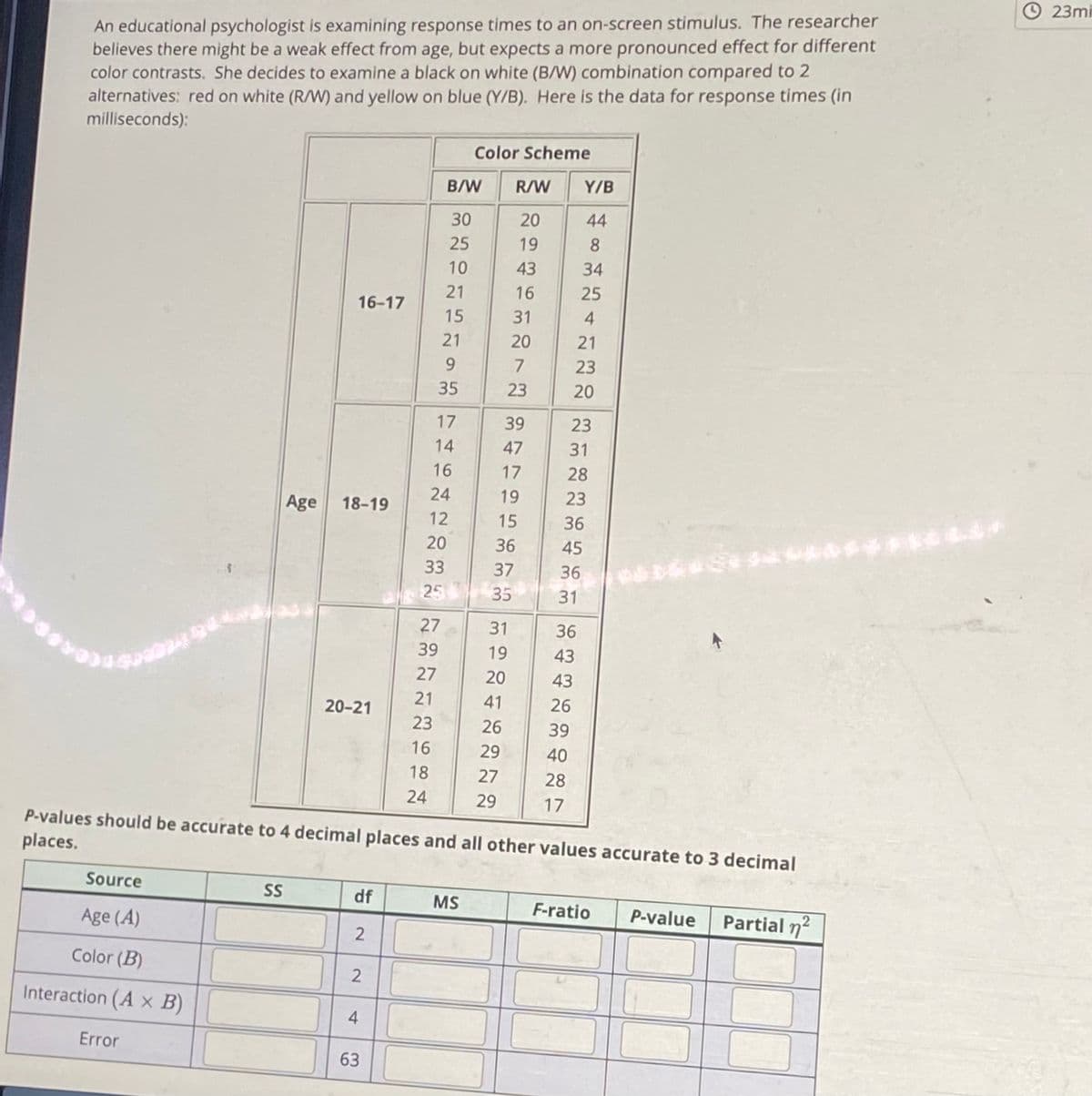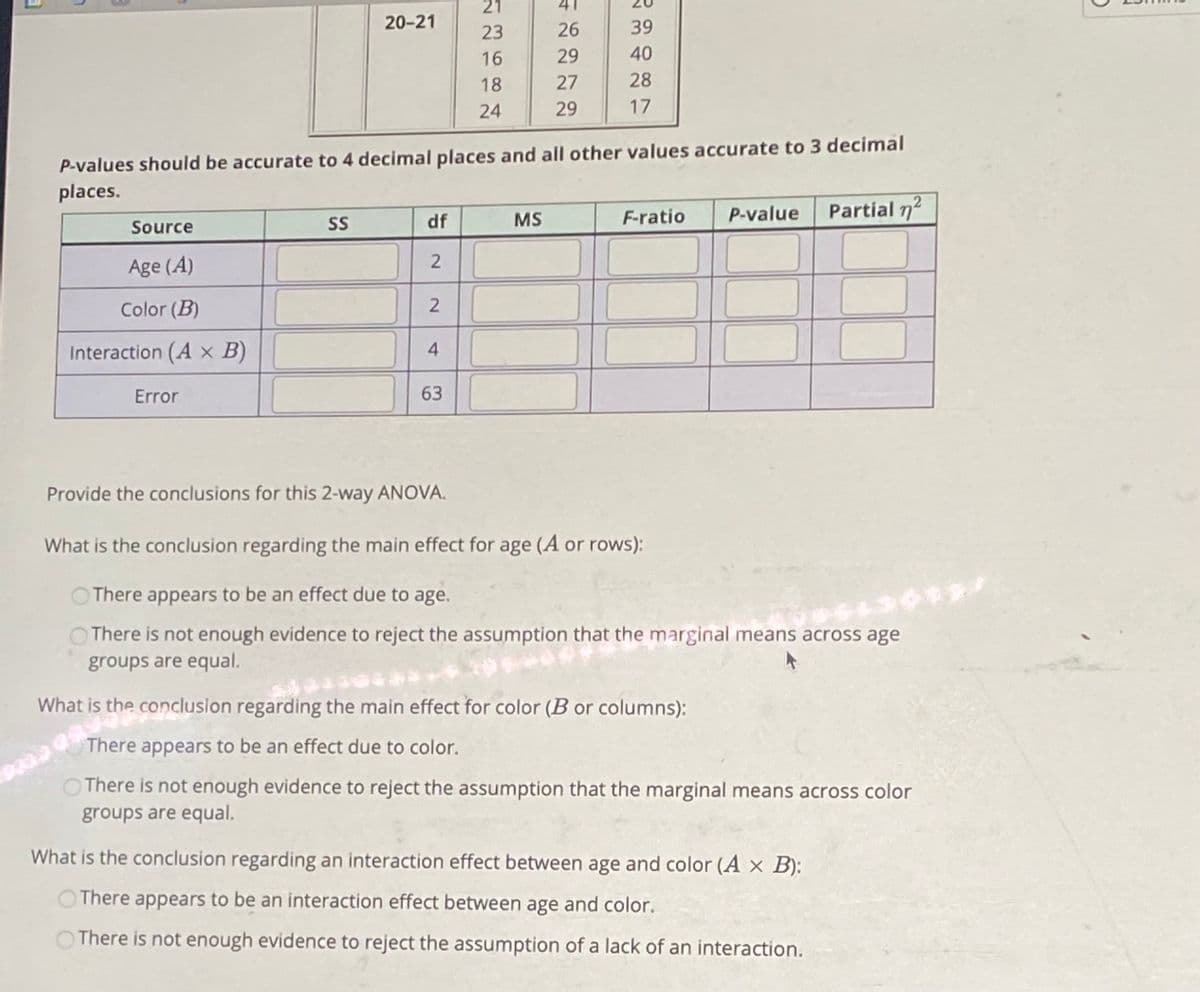An educational psychologist is examining response times to an on-screen stimulus. The researcher believes there might be a weak effect from age, but expects a more pronounced effect for different color contrasts. She decides to examine a black on white (B/W) combination compared to 2 alternatives: red on white (R/W) and yellow on blue (Y/B). Here is the data for response times (in milliseconds): Color Scheme B/W R/W Y/B 30 20 44 25 19 8. 10 43 34 21 16 25 16-17 15 31 4 21 20 21 9. 23 35 23 20 17 39 23 14 47 31 16 17 28 24 19 23 Age 18-19 12 15 36 20 36 45 33 37 36 25 35 31 27 31 36 39 19 43 27 20 43 21 41 26 20-21 23 26 39 16 29 40 18 27 28 24 29 17 P-values should be accurate to 4 decimal places and all other values accurate to 3 decimal places. Source SS df MS Age (A) F-ratio P-value Partial n2 2 Color (B) Interaction (A x B) Error 63 2) 41
An educational psychologist is examining response times to an on-screen stimulus. The researcher believes there might be a weak effect from age, but expects a more pronounced effect for different color contrasts. She decides to examine a black on white (B/W) combination compared to 2 alternatives: red on white (R/W) and yellow on blue (Y/B). Here is the data for response times (in milliseconds): Color Scheme B/W R/W Y/B 30 20 44 25 19 8. 10 43 34 21 16 25 16-17 15 31 4 21 20 21 9. 23 35 23 20 17 39 23 14 47 31 16 17 28 24 19 23 Age 18-19 12 15 36 20 36 45 33 37 36 25 35 31 27 31 36 39 19 43 27 20 43 21 41 26 20-21 23 26 39 16 29 40 18 27 28 24 29 17 P-values should be accurate to 4 decimal places and all other values accurate to 3 decimal places. Source SS df MS Age (A) F-ratio P-value Partial n2 2 Color (B) Interaction (A x B) Error 63 2) 41
Chapter4: Linear Functions
Section: Chapter Questions
Problem 33PT: For the following exercises, consider this scenario: The population of a city increased steadily...
Related questions
Topic Video
Question

Transcribed Image Text:© 23mi
An educational psychologist is examining response times to an on-screen stimulus. The researcher
believes there might be a weak effect from age, but expects a more pronounced effect for different
color contrasts. She decides to examine a black on white (B/W) combination compared to 2
alternatives: red on white (R/W) and yellow on blue (Y/B). Here is the data for response times (in
milliseconds):
Color Scheme
B/W
R/W
Y/B
30
20
44
25
19
8
10
43
34
21
16
25
16-17
15
31
4
21
20
21
9.
23
35
23
20
17
39
23
14
47
31
16
17
28
24
19
23
Age
18-19
12
15
36
20
36
45
33
37
36
25 35
31
27
31
36
39
19
43
27
20
43
21
41
26
20-21
23
26
39
16
29
40
18
27
28
24
29
17
P-values should be accurate to 4 decimal places and all other values accurate to 3 decimal
places.
Source
SS
df
MS
F-ratio
P-value
Partial n?
Age (A)
Color (B)
Interaction (A x B)
4
Error
63
2.
2)

Transcribed Image Text:21
41
20-21
23
26
39
16
29
40
18
27
28
24
29
17
P-values should be accurate to 4 decimal places and all other values accurate to 3 decimal
places.
F-ratio
P-value
Partial n2
Source
SS
df
MS
Age (A)
Color (B)
2
Interaction (A x B)
4
Error
63
Provide the conclusions for this 2-way ANOVA.
What is the conclusion regarding the main effect for age (A or rows):
There appears to be an effect due to age.
O There is not enough evidence to reject the assumption that the marginal means across age
groups are equal.
What is the conclusion regarding the main effect for color (B or columns):
There appears to be an effect due to color.
There is not enough evidence to reject the assumption that the marginal means across color
groups are equal.
What is the conclusion regarding an interaction effect between age and color (A x B):
There appears to be an interaction effect between age and color.
O There is not enough evidence to reject the assumption of a lack of an interaction.
2.
Expert Solution
This question has been solved!
Explore an expertly crafted, step-by-step solution for a thorough understanding of key concepts.
This is a popular solution!
Trending now
This is a popular solution!
Step by step
Solved in 4 steps with 1 images

Knowledge Booster
Learn more about
Need a deep-dive on the concept behind this application? Look no further. Learn more about this topic, statistics and related others by exploring similar questions and additional content below.Recommended textbooks for you


Glencoe Algebra 1, Student Edition, 9780079039897…
Algebra
ISBN:
9780079039897
Author:
Carter
Publisher:
McGraw Hill

College Algebra (MindTap Course List)
Algebra
ISBN:
9781305652231
Author:
R. David Gustafson, Jeff Hughes
Publisher:
Cengage Learning


Glencoe Algebra 1, Student Edition, 9780079039897…
Algebra
ISBN:
9780079039897
Author:
Carter
Publisher:
McGraw Hill

College Algebra (MindTap Course List)
Algebra
ISBN:
9781305652231
Author:
R. David Gustafson, Jeff Hughes
Publisher:
Cengage Learning

Algebra & Trigonometry with Analytic Geometry
Algebra
ISBN:
9781133382119
Author:
Swokowski
Publisher:
Cengage